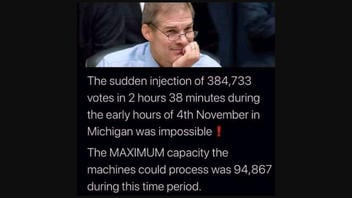
Does a "sudden injection" of close to 385,000 votes in Michigan prove election fraud? No, that's not true: There's often a delay between when absentee ballots are counted and when they are reported, leading to what may look like a sudden spike in votes. A spokeswoman for the Michigan secretary of state told Lead Stories: "This is common in every election and is due to the natural lapse between the physical process of running batches of ballots through a tabulator, and when that information can be collected and manually input by an election official. It is in no way indicative of fraud."
The claim appeared in a Facebook post (archived here) published on December 20, 2020. The post included a meme and an introductory message that said, "LMFAOOOOOOOO!!!!!! WOW!!!!" The meme itself read:
The sudden injection of 384,733 votes in 2 hours and 38 minutes during the early hours of 4th November in Michigan was impossible! The MAXIMUM capacity the machines could process was 94,867 during this time period.
This is what the post looked like at the time of writing:
LMFAOOOOOOOO!!!!!! WOW!!!!
Posted by Song Mi Kash on Sunday, December 20, 2020
(Source: Facebook screenshot taken on Mon Dec 21 16:33:45 2020 UTC)
The post did not cite any source, nor did it specify what areas in Michigan it was referring to. That said, its claim is identical to one that was alleged in a federal lawsuit filed by Sidney Powell, a former attorney for President Donald Trump. That suit cited an expert witness, Russell Ramsland, as saying that the 384,733 spike in votes, in less than three hours, was "physically impossible," given the equipment available at the four Michigan locations he looked at: Kent, Wayne, Oakland and Macomb. See here for a copy of his affidavit, in which Ramsland claimed:
The existence of the spike is indicative of a manual adjustment either by the operator of the system or an attack by outside actors.
But officials say the spike is not representative of when votes are actually processed and counted; it is not a real-time reflection. Tracy Wimmer, a spokeswoman for the Michigan secretary of state, explained that there can be delays between counting and reporting absentee ballots, leading to what may look like a sudden spike. She wrote to Lead Stories:
When counting absentee ballots there is often a delay between the actual counting process and when information is uploaded to the Qualified Voter File. This is common in every election and is due to the natural lapse between the physical process of running batches of ballots through a tabulator, and when that information can be collected and manually input by an election official. It is in no way indicative of fraud.
On December 7, 2020, a federal judge rejected Powell's lawsuit, which was based in part on the claim of absentee ballot fraud. In doing so, U.S. District Judge Linda Parker wrote that the suit "seems to be less about achieving the relief Plaintiffs seek -- as much of that relief is beyond the power of this Court -- and more about the impact of their allegations on People's faith in the democratic process and their trust in our government." She concluded:
Plaintiffs ask this Court to ignore the orderly statutory scheme established to challenge elections and to ignore the will of millions of voters. This, the Court cannot, and will not, do. The People have spoken.
















